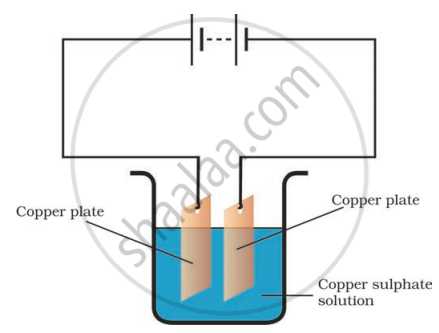Advertisements
Advertisements
प्रश्न
In the circuit given in the figure,
Boojho observed that copper is deposited on the electrode connected to the negative terminal of the battery.
Paheli tried to repeat the same experiment. But she could find only one copper plate. Therefore, she took a carbon rod as negative electrode. Will copper be still deposited on the carbon rod? Explain your answer.

उत्तर
Yes, Copper from the copper sulphate solution will be deposited on the carbon rod. When electric current is passed through the copper sulphate solution, copper sulphate dissociates into copper and sulphate.
The free copper gets drawn to the electrode connected to the negative terminal of the battery, i.e. carbon rod and gets deposited on it. Thus, Paheli will obtain a coating of copper on carbon rod.
APPEARS IN
संबंधित प्रश्न
If you pass current through copper sulphate solution, copper gets deposited on the plate connected to the ______ terminal of the battery.
Prepare a list of objects around you that are electroplated.
When electric current is passed through a conducting solution, there is a change of colour of the solution. This indicates
You are provided with a magnetic compass, an empty matchbox, a battery of two cells and connecting wires. Using these objects, how will you make a tester for testing an electric circuit? Draw the necessary circuit diagram and explain.
Explain the following:
Short circuit.
Liquids that conduct electricity are the solutions of ______.
Match the following
| 1. | Anode | a. | Conducting solution |
| 2. | Cathode | b. | Positive terminal |
| 3. | Ions | c. | Negative terminal |
| 4. | Electrolyte | d. | Positively or negatively charged |
Assertion: Parts of cars and bicycles are made iron with chromium coating.
Reason: Chromium does not corrode and resist scratches.
Name the process which shows the chemical effect of electric current?
State some advantages of electroplating.
